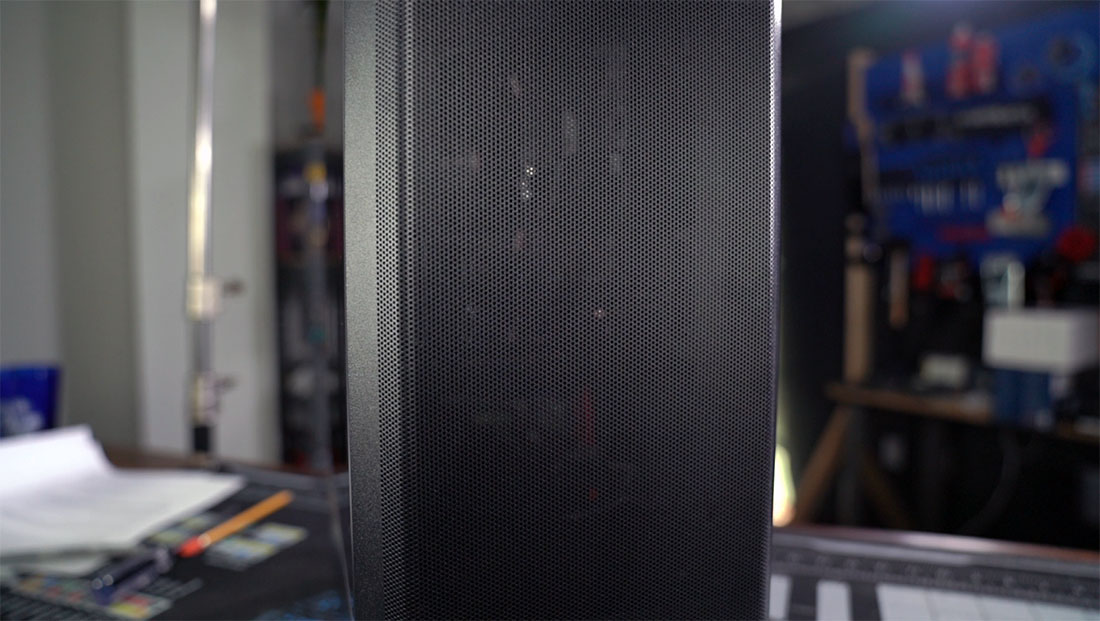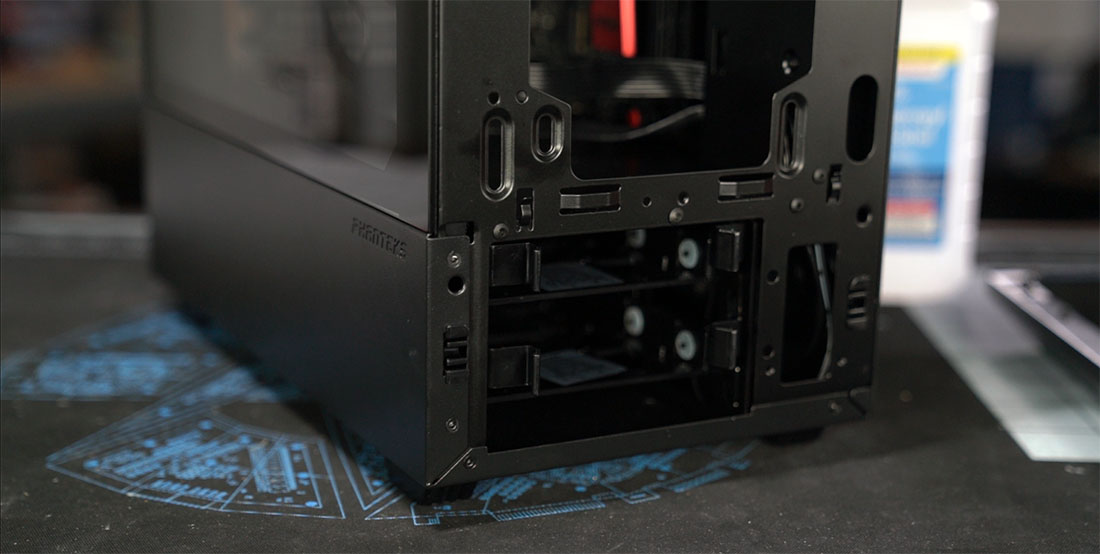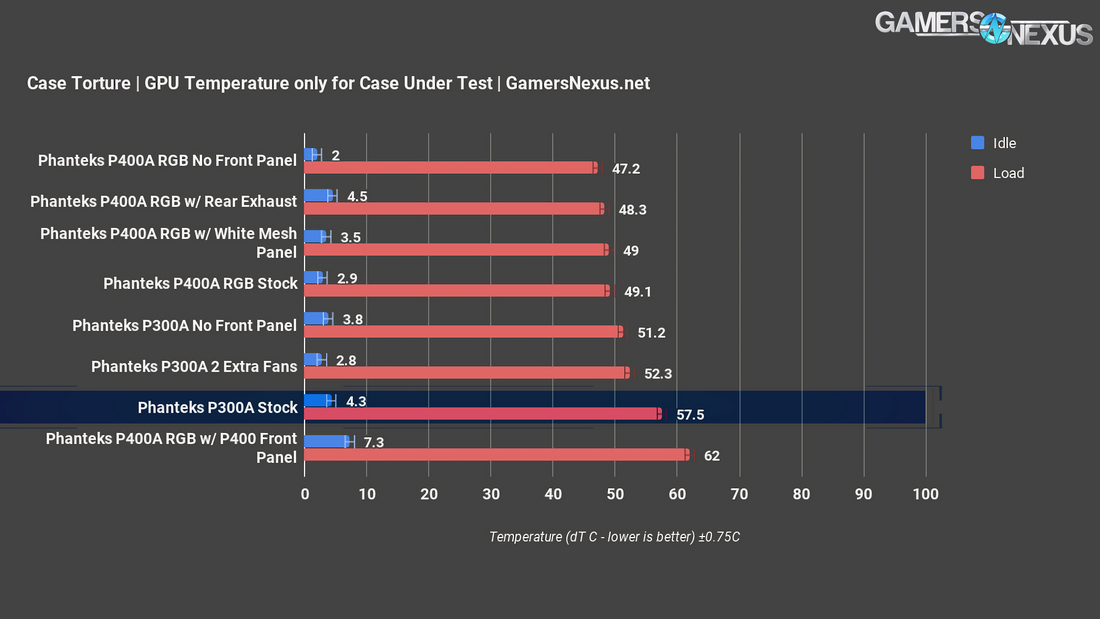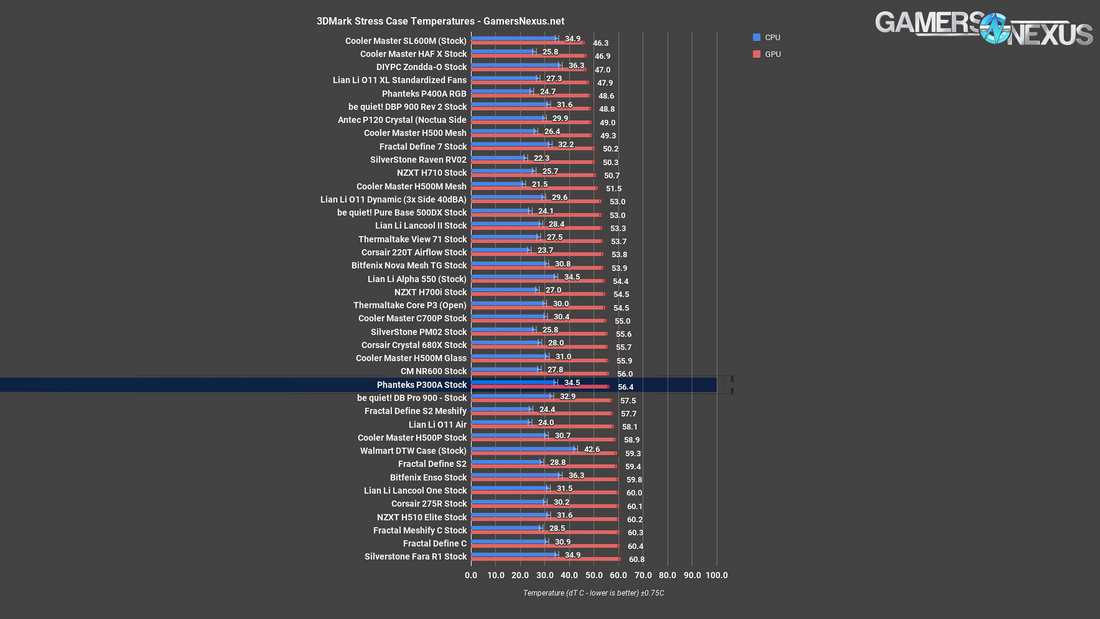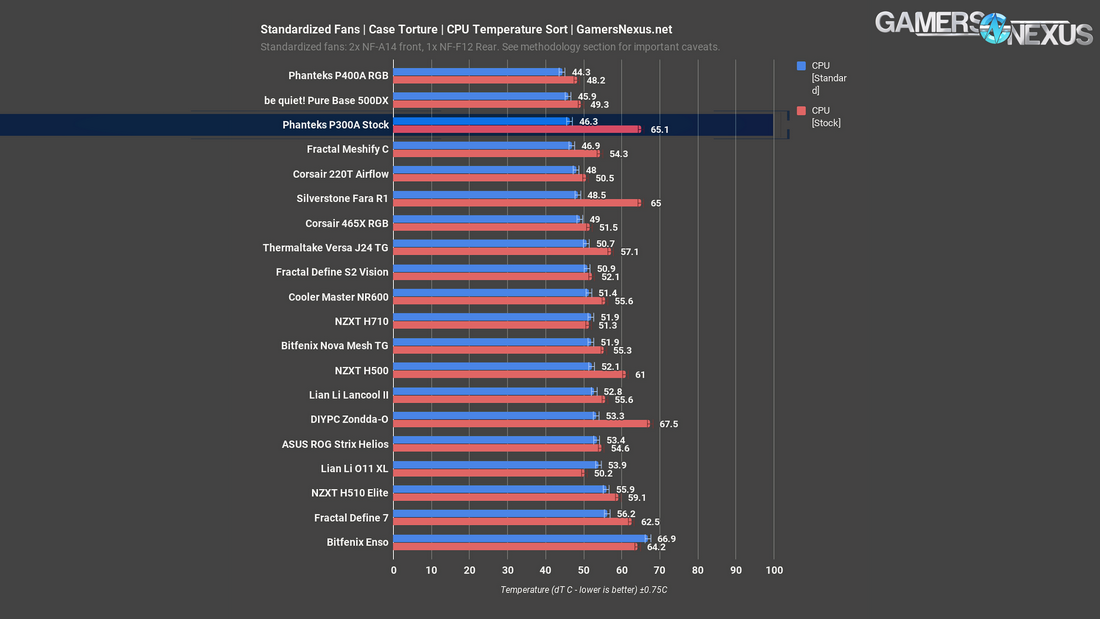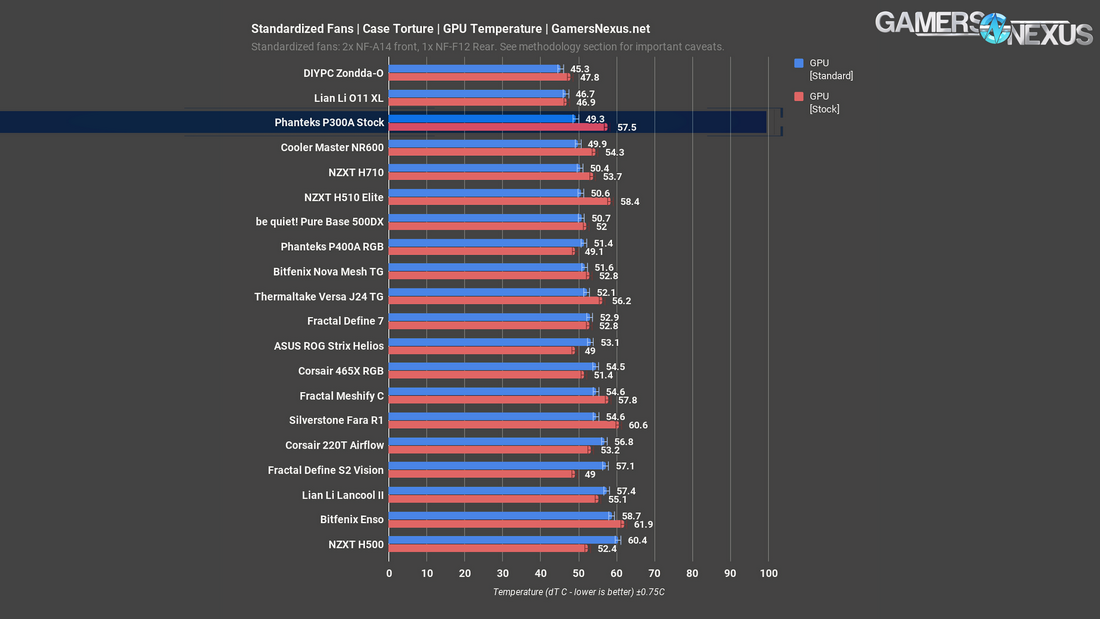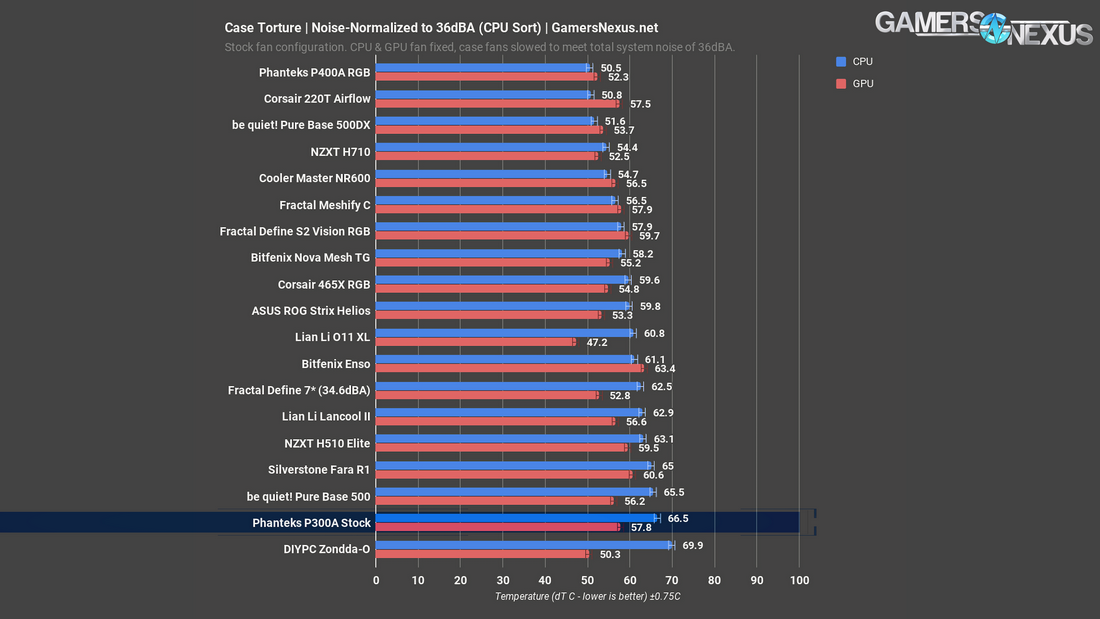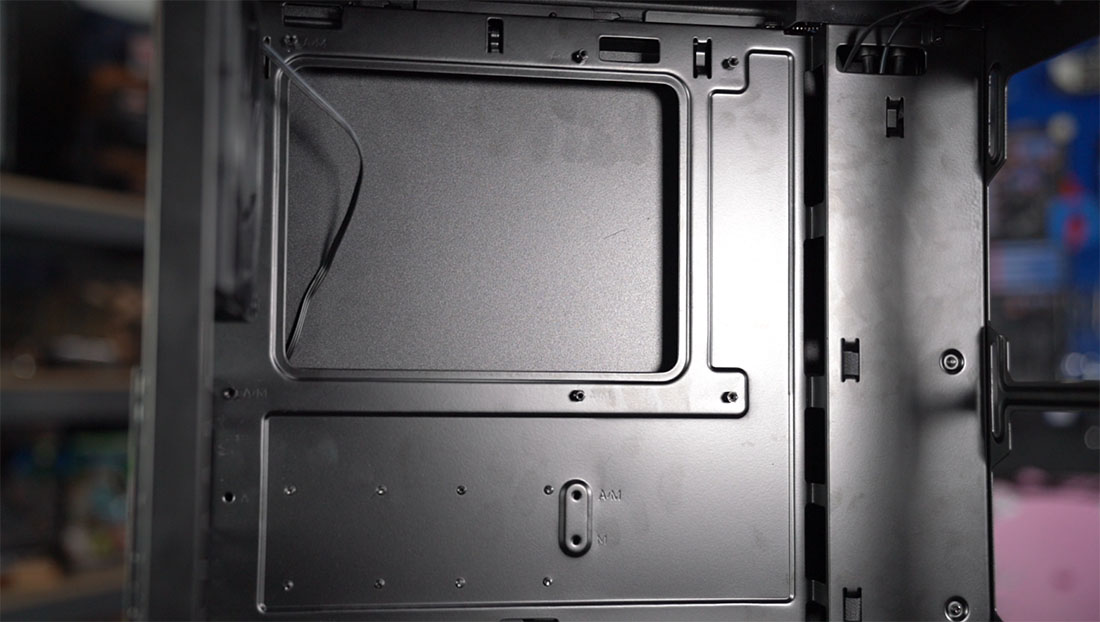The Phanteks P400A Digital was one of the most impressive cases we reviewed last year, providing good airflow and a full set of four fans for a reasonable price, but you’d be hard pressed to find it in stock for that price anywhere currently. The P300A is a newer and even less expensive option with the same style of mesh front panel that we covered at CES in January.
THE BUILD
The P300A is a smaller version of the P400A, and the P400A already wasn’t an especially large case. Space is tight, especially inside the PSU shroud. One way that Phanteks has addressed this is by rotating the HDD cage so that the drive sleds eject from the front of the case. This orientation is a little more convenient since the front panel is easier to remove than either of the two side panels, but plugging cables into drives will still probably require taking the side off. The major downside is that rotating the HDD cage leaves even less space between the cage and the PSU, so that there’s barely any space for cables. The cage is removable in pieces but not adjustable to other positions.
Dimension | 200 mm x 450 mm x 400 mm 7.8 in x 17.7 in x 15.7 in | ||
Form Factor | Midtower | ||
Materials | Steel chassis, steel exterior, ABS, glass | ||
Motherboard Support | ATX, Micro ATX, Mini ITX, E-ATX *(up to 275mm wide) [Ed. note: don't put EATX boards in this case] | ||
Front I/O | 2x USB 3.0, Mic, Headphone, Reset | ||
Side Window | Yes | ||
CPU Cooler Height Clearance | 165mm | ||
PSU Clearance | 200mm | ||
GPU Clearance | 355mm | ||
Front 240 Rad Clearance | 122x315mm | ||
Front 280 Rad Clearance | 142x315mm [Ed. note: 315 is max possible, not recommended] | ||
Fan/radiator mounts | Rear: 1x 120mm fan (1 fan included) Front: 2x 120/140mm fans (rads up to 280mm) Top: 1x 120/140mm fan (no rads) | ||
The P300A lacks the RGB lighting effects of the P300, but it retains a single dash of white light along the PSU shroud and an RGB control button which has been repurposed as a reset button. It’s a strange sight seeing a reset button replace RGB rather than the other way around. The minor lighting in the P300A isn’t obtrusive, but if Phanteks wanted to save a few pennies, this would have been the place to do it. We didn’t even notice the light until we’d started testing, and it led to some confusion when the not-an-RGB-control button on the front panel did nothing to change it.
The glass panel is a shortened design like the NZXT H500’s, and we still think this is the best route for budget cases with PSU shrouds. Spending money on a full-sized glass panel when a quarter of it is just going to show the side of a shroud makes no sense when every penny counts. Glass and steel panels are both held on by captive thumbscrews at the back, which is a change from the earlier P300’s design, which just used thumbscrews through holes drilled in the glass. We prefer the P300A’s design from both a functional and an aesthetic standpoint, but we’d like it even more if the glass slotted into the case along the whole bottom edge like it does on the H500. Still, points are deserved for the upgrade.
The front panel design is nearly the same as in the P400A, with a superfine mesh acting as both a front panel and a filter. This is the type of front panel we most prefer, followed by mesh front panels with additional filters that are easily removable. The P300A’s panel won’t catch dust quite as effectively as a traditional filter, but it gets the job done and it allows much more air through. Check our P400A review for more thoughts. One intriguing difference is the use of a plastic cover at the bottom edge of the front panel, which blocks off all the mesh below the level of the PSU shroud. That may initially sound like a bad thing, but there are no fan mounts at the bottom of the front panel, and leaving an empty gap here would just allow hot air to flow back out of the shroud and into the intake fans. We’ve seen limited effectiveness from these sorts of tweaks in the past, but it shows some thought put into the airflow layout--we don’t have a P300 on hand to compare with, but we know that it has vents at the top and bottom, so some retooling was required for this new design. The front panel is held on with the same plastic snaps that we complimented on the P400A: making the front panel easy to remove for cleaning and swapping parts is a worthy investment.
Mentioning the front panel means we have to revisit its single-fan choices: the P300A only comes equipped with a single 120mm stock fan, installed as exhaust behind the CPU. Cutting fans is one way to bring down the price of the case, but we believe including a full set of fans in budget cases is even more important than in higher-end ones, since case manufacturers can get a better price in bulk than a customer can trying to buy individual aftermarket fans. You’re not going to beat manufacturer pricing on included fans at this price-point, and $5 to the customer is worthwhile as an investment for an extra two fans. We’ll discuss this more in the thermal performance section of this review, but one fan is not enough, and that adds the hidden cost of at least one or two 120mm fans to the total price.
A feature we wouldn’t expect at all from a $60 case is a removable top panel. It’s not mentioned in the manual or product listing at all, and it’s not in any way convenient, but the entire top of the case can be lifted off independently of the top I/O to make building easier. Fifteen screws hold it in place, but they are definitely screws and not rivets, which would have been the cheap route. Getting the panel lined back up with all the screw holes and the top I/O is fiddly, and we wouldn’t recommend removing the panel on a regular basis, but it makes routing the CPU power connector and other cables at the top of the case much easier. For a case that’s intentionally as compact and cramped as possible, that’s a definite value add.
Radiator compatibility at the front of the case is claimed to be 280mm with clearance up to 315mm, but that’s generous--315mm is the total space between the top of the PSU shroud and the bottom of the front I/O. 315mm in total height is actually unusually short for a 280mm rad, and even ones that are that short will have zero wiggle room and may not line up with the mounting holes, like the Kraken x62. We recommend using a 240mm or smaller radiator for this case. Outside of that, mounting is fairly straightforward. Since nothing can be mounted below the level of the PSU shroud, there’s no caveat about only being able to install 360mm radiators tubes-up, which is more common than it should be. Please don’t install radiators tubes-up, by the way. Clearance between the mesh of the front panel and the fan mounts is 3cm, so fans could be installed on the front of the chassis inside the front panel if necessary. Clearance from the top fan mount to the top edge of the motherboard is also about 3cm, and the fan mount isn’t offset away from the board, so radiators won’t fit here and Phanteks doesn’t claim that they will.
The P300A is, unfortunately, one of the many cases that claims to be E-ATX without being able to fit a full 12”x13” motherboard. You can watch our piece on why E-ATX is a fake form factor that means nothing for more information. The maximum supported board width is 275mm according to the manual, but even that’s a stretch. We found the cable cutouts along the edge of the motherboard for the 24-pin power connector et cetera to be both narrow and at an inconvenient angle, with the holes positioned so that they point back towards the edge of the motherboard. A 275mm-wide board would butt-up against these cutouts and block them, requiring an alternate cable path. This case is no good for motherboards larger than full ATX, and even for full ATX boards we wish Phanteks would make the cutouts wider so that they wrap around the corner of the cable management bar and allow for better 24-pin cable routing.
THERMALS & NOISE
We stuck mostly to the usual test suite for the P300A, but we thought it deserved at least one extra test to demonstrate what performance would have been like if Phanteks had included a couple more stock fans. We picked two Arctic BioniX F120 fans from our inventory, installed them in the front intake slots positioned so that they wouldn’t be obstructed by the fan mounts, and carefully equalized their rotations per minute to the single stock fan (approximately 1300RPM). The F120s top-out at 1800RPM, but that’s not the point: we’re representing a cheap stock fan, were one included. The usual standardized fan test with three Noctua fans at full speed serves as an example of case performance with more expensive fans.
CPU TORTURE
Thermal testing starts with the baseline torture result for just the P300A and P400A, then we’ll add comparative tests. The P300A CPU temperature averaged 65 degrees Celsius delta T over ambient when stock. That’s not quite at the point of thermal throttling down from our overclock, but it’s close. Taking the front panel off lowered that to 55 degrees over ambient, but the test with no front panel still has only a single 120mm stock fan cooling the entire case. This isn’t to do with the panel being unbreathable -- we’ve proven, and can highlight again here, that the P400A-style panels are exceptionally high performing if without other blockages, like filters. In this instance, it’s a pressure equation: There’s not much airflow in the case and it’s entirely negative pressure, so removing any impedance will significantly help in a scenario in which there’s no intake at the front. This is also why testing a case, like the P400A, with fan speeds too low would lack the static pressure required to overcome the mesh, and thus potentially produce poor results. Removing the panel does allow more cool air to be drawn through the case from the front, but it’s still not nearly as good as just adding two front intake fans, which resulted in a dT of 47C while still having the front panel in place. We normally test with no front panel as a best-possible-case scenario to judge other results against, and to see how much the front panel design is restricting the thermal performance of the case. With so little active cooling in the stock case, any test which adds one or more fans will have far greater effect than just taking the front panel off. For the record, this front panel design isn’t restrictive at all--check our P400A Digital review for the comparison between front panel on vs. off there, which only lowered CPU dT by about four degrees. The P300A has a lot of potential, but you really need some fans for it. That might add to cost if they’re not lying around.
The comparative chart is next. 65 degrees over ambient is dangerously hot for our test bench, and is on edge of thermal throttling the CPU. This is not a case that should be used with only stock cooling. The score fits on the chart between the Fara R1 and the stock Pure Base 500 non-DX, which isn’t good. There’s limited purpose to comparing temperatures this high on the chart--it’s beyond the threshold of usability, and there’s no gradient between an F and an F+ in our system. Taking the +2 fans score as an indication of what a user should be able to achieve with another $10-$15, the P300A becomes massively more competitive, landing among the best results on the opposite end of the chart and even slightly outperforming the larger P400A. If MSRP were $70 with a couple extra fans, the P300A would be highly competitive with other cases near the 47C CPU dT mark, like the be quiet! Pure Base 500DX that we recently positively reviewed, or the Cooler Master H500M Mesh.
GPU TORTURE
GPU torture for only the Phanteks cases is next. GPU dT was 58 degrees in the torture test, which lowered significantly down to 52C dT with the removal of the front panel; again, to be exceptionally clear, that’s not because the panel itself is bad. It’s because there are not enough fans and any obstruction to the few present will be exacerbated. Removing the panel was all the help the GPU cooler needed, since testing with the added two front intake fans and the front panel back in place resulted in the same temperature. Remember also that GPU fans can create interesting pressure dynamics involving unanticipated intake through PCIe hole punches or other small holes near the back of the case. The stock exhaust fan is nowhere near the GPU, and without additional intake fans it’s essentially sealed in its own compartment at the bottom of the case and left to stew in its own heat. If adding only one fan to the case, we recommend positioning it as an intake that will benefit the GPU.
Here’s the comparative chart. As with the CPU test, the GPU dT with the stock configuration is among the hottest on our chart that isn’t completely out of control. Adding two fans didn’t cause such a dramatic swing as it did with the CPU test, but it still ties the Pure Base 500DX and is only one degree warmer -- roughly within error -- than the P400A. This case has the same general design as the P400A, and it deserves the P400A Digital treatment with a full set of stock fans.
3DMARK
The 3DMark Firestrike Extreme test pushed GPU dT up to 56 degrees over ambient, or about one degree lower than the torture result when decimal places are taken into account. Every slight increase in temperature means a decrease in clocks on the card to account for it, especially with temperatures this high. Adding another fan to the case will directly lead to better performance, however slight, and can aid in keeping cheaper systems alive where lower-life caps are used. 56C dT is on par with the Cooler Master NR600 in this test, another budget mesh-fronted case that we reviewed positively overall but critiqued for its underperforming stock fans.
STANDARDIZED FANS
Standardized fans are next. Before you read too far into this chart, please remember that standardized fan testing is inherently flawed, albeit still useful, in several ways. If you don’t actually know what our reasons are and you’re only guessing at them, please open a new tab with the link in the description about our standardized fan testing methodology for cases. CPU dT with the standardized set of fans was 46 degrees dT, close to the dT that resulted from installing two extra fans in a similar configuration. That ties the Pure Base 500DX as one of the best CPU temperature results on the standardized fan chart so far, although our pool of results for this test remains far lower than the others. The P400A scored a little better at 44C dT, but both of these are really excellent results compared to a more “normal” case layout with a closed front panel, like the Define 7 at 56 degrees Celsius dT. Given appropriate cooling, this case can really shine.
The GPU dT in this test was 49C over ambient, several degrees better than the test with just two 120mm fans added. Our standardized set of fans uses two 140mm intakes, which cover more area and force more air under the GPU. This is again a strong result in line with the other mesh-fronted cases, and the P300A actually outperforms the P400A by about two degrees here. Shortening the case slightly and not allowing any fan mounts below the PSU shroud means that two 140mm fans take up almost the entire breathable area of the front panel, pushing a wall of air back.
NOISE/NOISE NORMALIZED
Including only one fan in the case makes the P300A relatively quiet, but thanks to some audible vibration, we measured the noise level to be 36.7dBA at max fan speed, just slightly above the threshold for our noise normalized testing. Lowering the fan to 90% speed, or approximately 1270RPM, quieted this vibration, but the thermal results were predictably terrible.
We don’t consider this case usable with the stock fan alone already, and lowering its speed can only hurt performance. CPU dT climbed slightly from baseline to 67C, while the GPU remained at 58C dT and simply downclocked itself instead. That puts it between the two previous worst CPU dT results, the Pure Base 500 and the Zondda-O. It’s in better company for GPU temperatures, beating at least the Fara R1 and the Define S2 Vision RGB, but it’s still definitely on the warm end of the chart. As demonstrated with the P400A RGB, a case with tons of fans will still perform better thermally even with the fan RPMs lowered to equalize noise levels. The P400A has one of the best combined results on this chart, along with the Pure Base 500DX.
CONCLUSION
Over and over again, we find ourselves reviewing inexpensive mesh-fronted cases that have potential but perform poorly in stock tests, because over and over someone decides that the ventilation is good enough to excuse saving a few bucks by not including an adequate number of fans. We’ve seen it in the Meshify C, the NR600, and the Fara R1, just to name a few recent examples. The P300A is incredibly cheap for what it is and it’s got some features that we like, so this is still a positive review overall, but we’d advise treating this case like it costs $75 rather than $60 and including a couple fans with the order.
With that settled, there are two other major obstacles in the P300A’s way: availability, and the P400A. The P300A has evidently proven to be a very popular case even before this review, and it’s currently out of stock on both Amazon and Newegg. The Newegg out-of-stock listing is still set to $60, which is an encouraging sign--we often see retailers bump up the price over MSRP with popular cases.
The P400A Digital suffers similar availability issues, and some of the listings that do exist are far above the $90 MSRP that we recommended it at. Between the P300A and P400A, both at MSRP, we prefer the P400A. It includes a full set of stock fans, it has more interior space to work with, and it’s a slightly higher-end product. The P300A fills a niche for those who want a smaller case, but in reality it’s only about 1.5cm shorter (top to bottom) and about 7cm shallower (front to back). The factor that justifies its existence is, again, its price--the P300A is capable of similar performance to its larger sibling with added fans, and customers can choose to spend as little or as much as they want to on those added fans.
Editorial, Testing: Patrick Lathan
Host, Test Lead: Steve Burke
Video: Keegan Gallick
